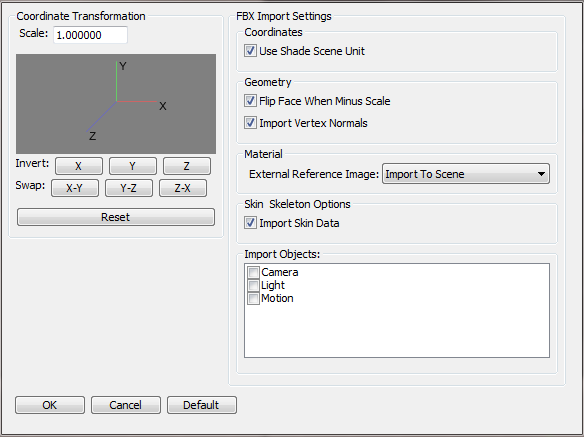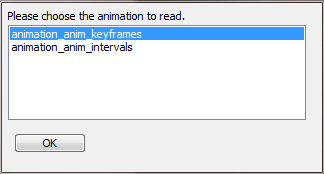FBX Import
Select File > Import > FBX... to open the FBX Import Settings.
FBX Import Settings
| FBX Import |
|---|

|
- Coordinate Transformation Group
-
- Scale
- Specify a numerical value to scale when importing a model.
- Invert Buttons
- Click the X, Y or Z button to invert the coordinate axis values of the import object.
- Swap Buttons
- Click the XY, YZ or ZX buttons to exchange the current axis values of the import object to the new value.
- Reset button
- Undo coordinate transformation changes made to Scale, Invert or Swap of the import object.
- Coordinates Settings
-
- Use Shade3D Scene Unit
- Specifies metric units used on FBX import.
When selected and if scene units are embedded in the FBX file, metric units within the FBX file are converted to millimeters (mm) within Shade3D.
If not selected, or if the scene units within the FBX file are disabled, the default metric of centimeters (cm) are used. Within Shade3D itself, metrics are multiplied by 10 to work with the default millimeters of Shade3D.
- Geometry Settings
-
- Flip Face When Minus Scale
- If the transformation matrix of imported parts or joints contain a minus scale value, polygon faces are flipped.
When checked, all imported parts and joints with a minus scale value will turn on the Flip Face checkbox automatically.
When unchecked, they are remain unchanged.
If used with Unity, QuickTime, 3ds Max, or Maya then select for import. If used with 3DXChange/iClone, then leave it unchecked. - Import Vertex Normals
- Import vertex normals from the FBX file.
- Import Vertex Color
- When selected, vertex color information is imported.
- Material Settings
-
- External Reference Image Pop Up Menu
- Select from Import to Scene or Keep External Reference to determine how texture maps are imported into the scene.
If the texture map itself is not embedded into the FBX file, the texture map exists in the form of an external reference.
Select Import to Scene if you want to import the texture map into your Shade3D file.
Select Keep External Reference if you want to preserve the external file reference within the Shade3D scene file and not import the actual texture map.
- Auto Convert Alpha Image into Transparency
- When selected, alpha transparency is automatically applied to mapping.
- Skin & Skeleton Options
-
- Import Skin Data
- If selected, polygon mesh vertices that have skin weight values are imported.
The imported data is stored in the Vertex Blend system.
- Objects to Import
- Select which types of objects to import from the FBX file: cameras, lights, or animation layers.
FBX Import Specifications
Object Import Specifications
All FBX structures including Skeleton, Null, Marker, Mesh, Nurbs, Patch, Camera and Light are recognized by Shade3D. The FBX file name becomes the default name of the object in Shade3D.
| FBX Objects | Shade3D Objects | Notes |
|---|---|---|
| Skeleton | Bone Joint | |
| Null | Part | |
| Marker | Not Supported | |
| Mesh | Polygon Mesh | |
| Nurbs/Patch | Polygon Mesh | Read in and converted to a Polygon Mesh. |
| Camera | Object Camera | Loads if Camera was selected in export options. |
| Light | Point Light, Spot Light, Directional Light, Distribution Light | Loads if Light was selected in export options. |
The FBX file format optionally supposes a Vertex Cache as a separate .mc file.
This type of Vertex Cache is not supported by Shade3D.
Polygon Mesh Import Specifications
The following applies when importing polygon meshes:
- Polyhedral object loading
- Mulitple UV Map support (8 layers maximum)
- If multiple materials are assigned to a single Polygon Mesh, then assign them all to a single Surface Material.
Importing the FBX Hierarchy of Polygon Meshes
In an FBX file, you can create an FBX hierarchy consisting only of a polygon mesh.
In this case, when importing into Shade3D, create a hierarchical part named polygonname_part (the polygon mesh name, an underscore, then the word part), then place the polygon mesh into that part.
Importing Camera Data
To import Camera data from an FBX file, from the FBX Import Dialog Box, in the Import Objects Group, select Camera.
Note Importing FBX Camera data does not include any camera animation.
Importing Light Data
To import Light data from an FBX file, on the FBX Import Dialog Box, from the Import Objects Group select Light. The light is translates to the equivalent Point Light, Spot Light, Directional Light or Distribution Light as defined in the FBX file.
If there is an FBX light named shade_distantlight present, then the light source is imported as a Distribution Light.
Note Importing FBX Light data does not include any light animation.
Importing Image Data
Images stored with an FBX file are loaded into your scene as a Master Image, including those that are not referenced from an object.
The file name of the image is the same as that of the Master Image.
If you set the External Reference Image pop up menu to Keep External Reference, then all image files will be treated as external referenced images.
Locating an image file used by an FBX file uses the following search methodology:
- Locate based on the absolute of the texture as described in the FBX file
- Locate based on a relative path (using the FBX file as a reference point) of the texture to the FBX file
- Locate within the same directory as the FBX file
- Locate within a directory with the same name as the FBX file
When the image file is not found, then the File Not Found dialog appears.

Click Verify and Continue confirm the selected file from the path to continue the process.
Click Ignore to skip the missing image file; click Ignore All to skip all missing image files.
If the image file cannot be found, then an error message appears in the Message Window with the relative path of the file information.
File Not Found - Textures/xxx.png
If a file exists in a designated path but in a format that is not supported by Shade3D (such as PICT), an 8 x 8 white image is inserted as a substitute.
Importing Materials
Material information contained within an FBX file is loaded into Shade3D as a Master Surface, including any that are not specifically referenced.
Material names within the FBX will be assigned to the equivalents within Shade3D. Supported materials and Surface Attributes are listed below.
When importing for mapping, one image is supported for each attribute.
When Shade3D imports FBX files, it can include texture data (and associated UV settings), including material tiling and horizontal/vertical orientation information. For example, an FBX file includes UV coordinate settings of (-2, 3) is interpreted by Shade3D as follows:
The U is a negative value, so the flip horizontal is set to ON.
The V is a positive value, so the flip vertical is set to OFF.
Material tiling is (-2, 3), meaning the material is repeated 2 times on the U coordinates and 3 times on the V coordinates, with any decimal value rounded off; negative or positive values do not otherwise affect material tiling.
While the FBX format can include UV coordinate information such as Rotate and Offset, Shade3D supports Repeat Image (material tiling) only.
Image mapping on import has the Smooth option applied by default, as modified by Surface Tab > Mapping > Image Tab > Smooth checkbox.
When transparency is assigned to a mapped image, Shade3D treats transparency with transparency applied as the color becomes closer, or blends to white; the FBX format applies transparency as the color becomes closer to black.
When importing with transparency into Shade3D, select the Invert option to invert the color of the mapping.
Importing Animation Layers
An FBX file can have multiple animation layers within their Animation Stack.
When these are available, the Animation Import dialog appears.

If from the FBX Import Dialog Import Objects Group you select the Motion checkbox, animation data imports if present.
An FBX file can contain multiple animation timelines. You can select one to import from the FBX file.
The Animation Import dialog does not appear if the Motion checkbox is unselected in the FBX Import Dialog.
When there is only one Animation Stack, the Animation Stack is imported without the Animation Import dialog appearing.
Loading Animation
FBX supports motion curves of Move, Rotate and Scale. Animation is key frame based.
Animation itself can be imported using two different methodologies in Shade3D.
- FBX Skeleton as Bone
FBX Seleton based animation imports in as a Shade3D Bone joint.
Animation data that is the equivalent to Move and Rotate in Shade3D is used as a basis of keyframes for animation, while Scale is not used.
- Mesh based animation utilizes ball joints storing some animation data for a polygon
mesh.
The polygon mesh itself, as the Mesh object of FBX can perform keyframe animation.
Since a polygon mesh in Shade3D cannot store animation data, insert a ball joint named "polygonmeshname"_center into the polygon mesh. The ball joint then can work with keyframe based Move and Rotate actions.
FBX Importer Message Window
When Shade3D finishes importing an FBX file, a the Message Window appears.
| Item | Contents |
|---|---|
| import | The full path name of the FBX file you import |
| application name | The application used to save the FBX file |
| application vendor | Name of the vendor of the application used |
| title | Title of the FBX file |
| subject | Subject information |
| comment | Comment information |
| author | Author or Creator information |
| keywords | Keyword information |
| revision | Version information |
| fbx version | Version information of the FBX format |
| shapes | Number of polygon meshes |
| materials | Number of Master Surfaces |
| textures | Number of Master Images |
| cameras | Number of Cameras |
| lights | Number of Lights |
| animation | Animation Stack Name |
If the image specified within the FBX file cannot be found, the relative path of the external reference is displayed in the Message Window as below:
File Not Found - Textures/xxx.png
Important Notes Regarding FBX Import
- OpenSubdiv Edge Sharpness values are supported and imported automatically.
- The FBX Importer supports the FBX 2012 format specifications.
- In the Mac App Store version of this product, you will not be able to read in FBX files that are located outside of the home directory of the logged in user. You should store all FBX files in your home directory.
- In the Mac App Store version of this product, if you load a texture image outside of the home directory of the logged in user, the texture image will fail to load. Keep the images you want to use in your home directory. If you place image files in the same directory as the FBX file, you can always read the file, regardless of the specificed reference path set in the FBX file.